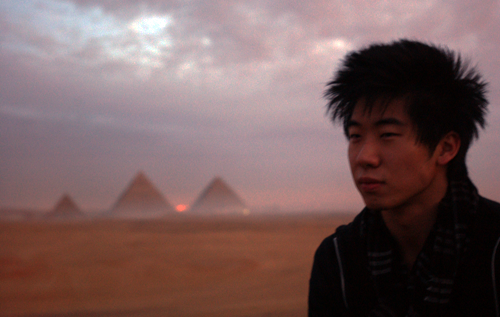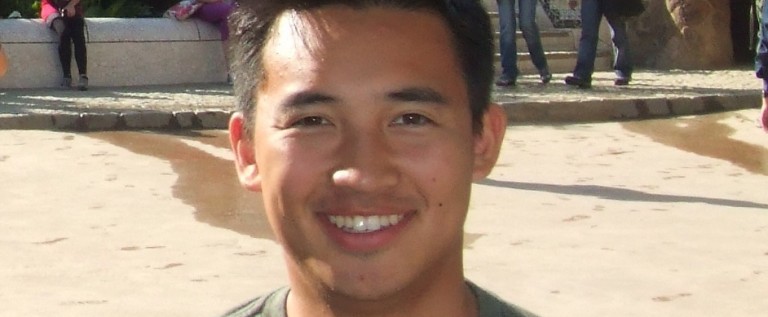Seibi Lee: A Day in the Life of a Dancer

Seibi Lee began her Catha studies with Pandit Chitresh Das in Toronto, Canada in 1991. Realizing the importance of studying intensely and directly with Panditji, Seibi relocated to the Bay Area in 1998. She began touring nationally and internationally with the acclaimed Chitresh Das Dance Company in 2003 and, as principal dancer at CDDC, has earned rave reviews for her dual dramatic roles of demon Marich and beloved monkey prince Hanuman in Panditji’s world premier of “Sita Haran” in San Francisco, Los Angeles, and Kolkata, India. In Novemeber of 2008, she presented her debut full length solo performance at the Oakland Asian Cultural Center and has been chosen as OACC’s artist-in-residence for 2012-2013. Seibi embodies the depth of Panditji’s training and has emerged as a dynamic and powerful force in the next generation of Kathak artists. Currently, Seibi is Co-Director and senior instructor of the Chhandam School of Kathak and Director of the Chhandam Youth Dance Company.
SK: Seibi, what is Kathak Dance? How did you find out about Kathak Dance? You were a musician prior becoming a professional dancer.
SL: Kathak is one of the major classical dance forms of India and is unique in its confluence of Sanatana Dharma/Hindu traditions from thousands of years ago and the Persian/Mughal traditions starting in the 1500s. Kathak has developed over these many years to incorporate elements of story telling and pure dance. A dancer must be well established in the 4 aspects of Kathak: tayari – technique, laykari – deep understanding of rhythm, khoobsurti – gracefulness and beauty, and nazakat – nuances of beauty (subtle movements associated with the neck, eyebrows, wrists and breath). The storytelling aspect is based on the beautiful philosophical concept of ardhinaraswara. Literally this means half female half male but embodied in this idea is the potential for each person to recognize these qualities and to be able to bring them out in the dance and to be able to depict all the characters including male/female, old/young, animals/elements of nature.
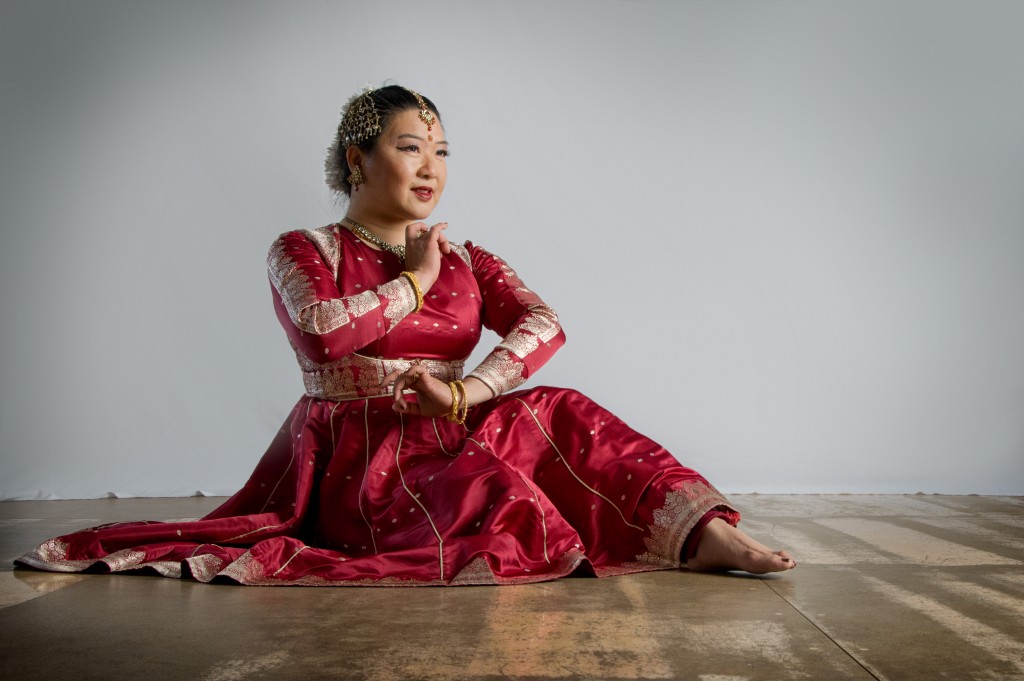
Photo credit: Eric Mindling
In 1991, I saw a performance of a former student of Pandit Das and was intrigued by the dynamic range of the art form. In the fall of that year, Joanna De Souza, disciple of Panditji, brought her Guru to Toronto and I took a week long intensive with him. At that time, I had finished a BSc and was working towards a MA in music performance specializing in harp and I found that all my education and life experience was somehow reflected in Kathak. As I was already on my way to establishing my music career, I continued with that path in conjunction with beginning my studies in Kathak.
SK: You began your Kathak studies with Pandit Chitresh Das in Toronto in 1991. You moved to San Francisco following your Master 8 years later.
What was it like to study under the guidance of world-renowned Master? He is called a phenomenon.
SL: The week-long intensive that I experienced in 1991 is still etched in my heart today. In Toronto, I continued studying with Joanna and with Panditji who came regularly every year. I then moved to Vancouver, where there was no established teacher of this lineage so I maintained a personal practice and attended intensives in Toronto and retreats in California. During this time alone, I came to realize the depth that Kathak had touched my soul and the importance of studying from the source Guru Pandit Chitresh Das. I have been in California since 1997.
Rarely, the forces of nature and circumstance come together to bring forth a true source Guru. Born to dancer parents Nilima and Sri Prohlad Das who had their own school Nritya Bharati in Kolkata, Panditji grew up surrounded by the most illustrious dancers and musicians. A dance prodigy, Panditji began his Kathak studies at the age of 9 with his Guru, Pandit Ram Narayan Misra who was known for his bhao and abhinaya (story telling and expression). His pioneering spirit infused with this history, education, and life experience brought him to America has produced a Guru who is both grounded in tradition and yet has the ability to innovate within this tradition, who is a fantastic performer himself (still captivating and bringing audiences to their feet today at age 68), who is an extraordinary choreography and composer and who is an exceptional teacher. It is a remarkable honor to study under such a Guru who sees the highest potential in each and every student and gives all his energy to guide each student before him to reach their own potential.
SK: How many hours do you train a day?
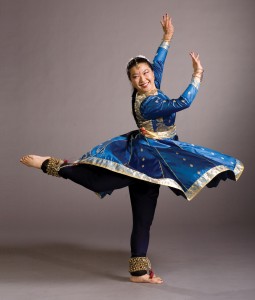
Photo credit: Mary Sohl
SL: In Chhandam, we follow 9 Principles. The first is Sadvyvhaar aur Tehzeeb (Attitude and Ettiquette) – One must approach the study of Kathak with humility, an open mind, and respect for oneself and for the Guru. The third is Riyaz mehenat ke saath (Systematic practice with deep exertion). It is important to train 6 days a week and take 1 day of rest. Training encompasses personal riyaz during which it is crucial that the dancer is able to push themself to gain stamina and technical prowess on their own and not rely on the energy of their master to keep moving forward; time with the Guru who guides the disciple on the right path; and deep study of the history, philosophy and sophisticated mathematics underlying the art form. Currently, we have company class/rehearsals 3-4 times a week (1.5 – 3 hours each) and I maintain my own personal daily practice and studies 2-4 hours.
SK: You said that you become a dancer because you love it. The road for a solo dancer is challenging. What are some challenges? What would you say to young dancers today who want to pursue a dance as a professional career?
SL: There are many careers that can be both financially practical and also something that the person is passionate about. Art is most usually not so financially practical and is a road followed because the practitioner cannot live without it. When I first entered university, I tried the path of my parents and went into the sciences with the goal of becoming a doctor. Although quite capable in the sciences, something was missing from my life. My mother had put me in 3 things when I was 5 years old: ballet, piano and violin. I was quite and active child so she was able to focus and settle me down with these activities, however, her intention was to supplement an education that would lead me to medicine. I appreciated music but did not want to become a musician with either of those instruments and I loved dance but did not have the ballet body type. In the 3rd year of my science degree, I discovered the harp. Luckily, my music background allowed me to consider taking this seriously and I found that this instrument gave me an expressive outlet that I had been missing since I had let go of dance in my teens. After completing my BSc, I entered music and thrived greatly in that environment. I completed my MMus and carried on a successful career in freelance orchestral and chamber music for 25 years. Kathak came into my life when I was 26 years old – quite late in life for and art form as physical as dance. All of the various paths in my life converged here but I also understood that it would take some time for me to realize its place in my life and few years ago, I let go of the professional harp career to concentrate all of efforts in the dance.
Each person’s challenges will be unique but much rests on finances and reputation. When you are a freelance artist, you face a double bind situation in that no one wants to hire you because you do not have a reputation, but you need people to hire you to establish your reputation. This is where a combination of hard work, faith and some amount of luck come into play.
Some talented artists lose themselves here, some not so talented artists are blessed with fortunate circumstances, some very talented artists are recognized and with vision take themselves and the art form forward into the future. Pandit Das’s vision was to bring Kathak to America and with his ghungroo (dance bells), his tabla (drums) and $8 in his pocket. Over the last 40 years, he has established himself as the premier Kathak maestro internationally and his dance institution Chhandam has over 500 students in California (with branches in the Bay Area, Sacramento and LA) and sister schools in Boston, Canada and India (Mumbai and Kolkata).
SK: You began touring with nationally and internationally acclaimed Chitresh Das Dance company in 2003, and as principal dancer. What was your first experience performing in India? I remember right after your magical performance this month at the Oakland Asian Cultural Center, a friend of my friend said to me, “Oh, my gosh. She is great! And she is not even Indian!” I heard him saying this to you as well!
SL: My first trip and performance experience in India was in December 2003-January 2004. It was a whirlwind experience as the dance company was presenting a number of Panditji’s works in Kolkata: Panchajati (based on 5 South Indian rhythmic structures overlaid a North Indian melodic and rhythmic cycle of 16 beats) at the Birla Sabhaghar and Goldrush (a dance drama in pure Kathak style based on the Calfornia Goldrush) at the Calcutta Club. As important as it is to travel to the source of knowledge personified in a Guru, it can also be important to travel to the source of the dance form India, to see the land, the people and the history. The art form itself is universal and transcends the boundaries of its country of origin, for this reason, Kathak is flourishing in America under Panditji.
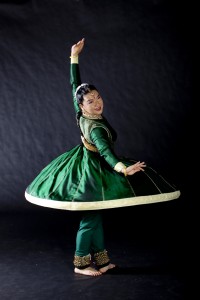
Photo credit: Brooke Duthie
SK: You are currently co-Director and Senior Instructor of the Chhandam School of Kathak which is the largest school of Kathak dance in Northern California. What is your vision for school and next generation of young dancers?
SL: Kathak is such a deep and rich classical art form. My vision is that Kathak will be recognized and respected as widely as forms such as ballet and that students of all generations and nationalities will consider the study of Kathak part of a comprehensive education. My vision for young dancers is that Kathak will be a viable career path for them to choose. Our organization is working tirelessly as an institution to forge a pathway for dancers to support themselves through dance inclusive of teaching, performance and administration. I have been able to do so for a number of very fulfilling years as Co-Director Chhandam School and will be stepping down from this position to concentrate more fully on performance and teaching.
SK: Seibi, what is your biggest achievement in life?
SL: I think that I am still working towards my biggest achievement but so far, I think that one of my achievements has been to be able to communicate with and inspire others through art both in music and dance through performance and teaching. It is of great consequence to appreciate fully the gifts and knowledge that that one receives and to give back with integrity to the world.
SK: Who is your source of inspiration and motivation in life?
SL: Without doubt, Pandit Das as he leads and guides by example. He never asks of a student what he does not ask of himself. He also says that Mother is the first guru, Father the second and the third is oneself. It is crucial that each of us looks within first to find inspiration and motivation. This is where all potential lies. The source Guru can guide us to reach that potential by helping us to recognize and taking responsibility for it.
SK: What is your motto?
SL: Yoga comes from the Sanskrit word “yug” – to join. “Kathak joins mind, body and spirit and is my yoga.”
Passion is an element of Fire.
Empathy is an element of Earth.
Transformation is an element of Wind.
Suppleness is an element of Water.
Serenity is an element of Space.
SK: It was such a great pleasure to watch your performance, and I enjoyed our conversation. Wishing you all the best that life can offer. Thank you.


